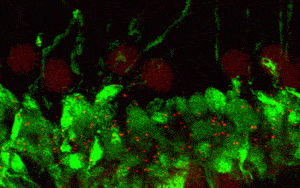Researchers at King’s College London and the Wellcome Trust Sanger Institute in the United Kingdom have for the first time demonstrated a direct link between a novel gene, Wbp2, and progressive hearing loss.
The scientists report that the loss of Wbp2 expression leads to progressive high-frequency hearing loss as was seen in mouse studies, as well as in two clinical cases of children who had deafness with no other obvious features. The results are outlined in an article in the February 8, 2016 online edition of EMBO Molecular Medicine.
With this study, the scientists have shown that hearing impairment is linked to hormonal signaling rather than to hair cell degeneration. Wbp2 is known as a transcriptional co-activator for estrogen receptor Esr1 and progesterone receptor Pgr. The loss of Wbp2 causes not only progressive high frequency hearing loss, but also results in reduced expression of Esr1, Esr2 and Pgr in the cochlea, or inner ear. The researchers explain that understanding the estrogen-sensitive molecular networks specific to hearing offers a new target for the control of the estrogen signaling pathway in the auditory system that could prevent or reverse progressive hearing loss.
“Our study demonstrates that hearing thresholds are normal in young Wbp2 mutant mice, but are raised at high frequencies by four weeks of age,” said senior study author and EMBO Member Karen Steel, PhD, of King’s College London. “More importantly, we also demonstrate that Wbp2 is crucial for hearing in humans. We found two children affected by severe to profound deafness, each carrying two variants of the WBP2 gene.”
While progressive hearing loss is a common health problem, very little is known about its molecular mechanisms. As a result, targets for medical therapies have been lacking. It has been known that estrogen signaling protects against noise-induced hearing loss. However, estrogen-based therapies have not been generally considered for hearing impairment due to their widespread effects. The authors hope that this study opens up the Wbp2 pathway as a new route to therapeutic approaches that more specifically target the inner ear.
Sources: EMBO; King’s College London; Wellcome Trust Sanger Institute
Image credit: EMBO Molecular Medicine; King’s College; Wellcome Trust





